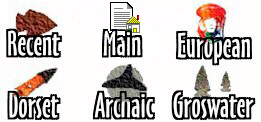![[Header]](religious.jpg)
Dorset Art and Spirituality
The Dorset culture made beautiful three-dimensional carvings from bone, ivory, tooth, wood and soapstone. The main theme of their works was to show their close association with the animals in their environment upon which they depended, such as the polar bear, caribou, seal, walrus, fox and fish. Other carvings depicted human images. Many of the amulets would have been pierced and sewn to clothing of the person, in the belief that the bearer would acquire some attributes of the animal represented in them. Some of the carvings may have belonged to shamans who were believed to be able to turn into animal spirits, in particular the polar bear.
Some of the burial sites were found along the shore in caves. There are three burial caves found in the Port au Choix area. The Crow Head Cave was disturbed, looted and blown up by dynamite. There appear to have been about five to six sequential burials there. It was excavated by Dr. Stuart Brown of Memorial University of Newfoundland in 1986.
The Gargamelle Cave was also disturbed by the local residents. Dr. Brown who excavated it in 1986 believes this was a single event burial where possibly an extended family met a common fate. There were eight to nine skeletons, including one male and two female adults, two adolescents, one two-year-old child, and one neonate. Bones from this burial were given to Dr. Elmer Harp in the late 1950s.
The Eastern Point Cave was most likely a third burial site disturbed by the local residents. This site was the one probably mentioned by James Howley in 1915. The only bones found were very small, such as those of toes, fingers and teeth. Twenty-four artifacts of the Dorset culture, including a small effigy of a polar bear were found. It is believed that at least two individuals were buried here; one adult and one juvenile. There have been more buried in this cave but nothing is known of the skeletal remains which were uncovered by a local resident at the turn of this century.
Links to other
aspects of the Dorsets:
Religious Aspects
